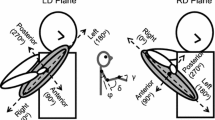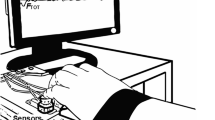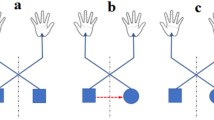Abstract
We have previously demonstrated that, in preparing themselves to aim voluntary impulses of isometric elbow force to unpredictable targets, subjects selected default values for amplitude and direction according the range of targets that they expected. Once a specific target appeared, subjects specified amplitude and direction through parallel processes. Amplitude was specified continuously from an average or central default; direction was specified stochastically from one of the target directions. Using the same timed response paradigm, we now report three experiments to examine how the time available for processing target information influences trajectory characteristics in two-degree-of-freedom forces and multijoint movements. We first sought to determine whether the specification of force direction could also take the form of a discrete stochastic process in pulses of wrist muscle force, where direction can vary continuously. With four equiprobable targets (two force amplitudes in each of two directions separated by 22° or 90°), amplitude was specified from a central default value for both narrow and wide target separations as a continuous variable. Direction, however, remained specified as a discrete variable for wide target separations. For narrow target separations, the directional distribution of default responses suggested the presence of both discrete and central values. We next examined point-to-point movements in a multijoint planar hand movement task with targets at two distances and two directions but at five directional separations (from 30° to 150° separation). We found that extent was again specified continuously from a central default. Direction was specified discretely from alternative default directions when target separation was wide and continuously from a central default when separation was narrow. The specification of both extent and direction evolved over a 200-ms time period beginning about 100 ms after target presentation. As in elbow force pulses, extent was specified progressively in both correct and wrong direction responses through a progressive improvement in the scaling of acceleration and velocity peaks to the target. On the other hand, movement time and hand path straightness did not change significantly in the course of specification. Thus, the specification of movement time and linearity, global features of the trajectories, are given priority over the specific values of extent and direction. In a third experiment, we varied the distances between unidirectional target pairs and found that movement extent is specified discretely, like direction, when the disparity in distances is large. The implications of these findings for contextual effects on trajectory planning are discussed. The independence of extent and direction specification and the prior setting of response duration and straightness provide critical support for the hypothesis that point-to-point movements are planned vectorially.
Similar content being viewed by others
Author information
Authors and Affiliations
Additional information
Received: 6 August 1996 / Accepted: 18 December 1996
Rights and permissions
About this article
Cite this article
Ghez, C., Favilla, M., Ghilardi, M. et al. Discrete and continuous planning of hand movements and isometric force trajectories. Exp Brain Res 115, 217–233 (1997). https://doi.org/10.1007/PL00005692
Issue Date:
DOI: https://doi.org/10.1007/PL00005692




